C4D Analysis of Acetylchorine Chloride on a Prince CE System
The eDAQ C4D system was connected to the PrinCE-C 600 capillary electrophoresis instrument and acetylcholine chloride was analysed.
Introduction
The eDAQ C4D system was connected to the PrinCE-C 600 capillary electrophoresis (CE) instrument as described in the application note C4D004. Acetylcholine chloride (AChCl) was then analysed and a calibration curve was produced. The CE instrument was set to negative mode and the C4D system measured the Cl- anions.
Conditions
- Analyte: Acetylcholine chloride (AChCl) dissolved in water, analysed at the concentrations 10 mM, 50 mM, 100 mM, 500 mM and 1000 mM
- Buffer:
- MES/Arg/CTAB with pH 5.7, where
- MES is 2-(N-morpholino)ethanesulfonic acid,
- Arg is L(+)-Arginine,
- CTAB is hexadecyltrimethylammonium bromide
- Instrument:
separation voltage = 30 kV recorded separation current = 11 – 12 µA
- Capillary:
outer diameter = 360 µm internal diameter = 25 µm length = 56 cm length to detector = 42 cm
- Injection: pressure 300 mbar for 10 seconds
- C4D: frequency = 500 kHz
amplitude = 100 A headstage gain OFF
- Data recording:
lowpass Filter = 1 Hz range = 50 mV sampling rate = 100 data points per second
Data Analysis
Figure 1 shows the AChCl peaks at the different concentrations. Figure 2 shows how the software can automatically produce a calibration curve by plotting the peak areas versus known concentrations of analyte.

